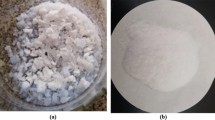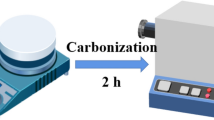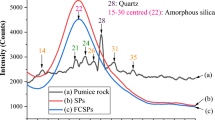Abstract
In this paper, the sorption of uranium onto nanoporous silica adsorbent in the presence of nitrate, sulfate, chloride, fluoride and phosphate was studied. The effect of contact time between the nanoporous sorbent and aqueous solution, pH and initial concentration of uranium was also investigated. Uranium sorption onto nanoporous silica adsorbent is a very fast process as sorption rate increases with pH increment. Optimum pH for uranium sorption was 4–8. Experimental sorption isotherm is successfully described by Langmuir and Freundlich models. The results obtained by batch experiments showed that the presence of high concentration of nitrate, sulfate, chloride and phosphate anions alone had no interference with uranium recovery. However, the presence of fluoride ions (>250 mg/L) decreases uranium sorption by about 55 %. The results also showed that the presence of phosphate ions (about 300 mg/L) in solution could remove fluoride interference completely. Finally, the efficiency of the nanoporous silica adsorbent for uranium recovery from wastewater of the uranium conversion facility was investigated.









Similar content being viewed by others
References
Akhtar K, Khalid AM, Akhtar MW, Ghauri MA (2009) Removal and recovery of uranium from aqueous solutions by Ca-alginate immobilized Trichoderma harzianum. Bioresour Technol 100:4551–4558
Amamoto I, Terai T, Oobayashi H, Fujit R (2005) Separation and recovery study of uranium from spent NaF (fillers). J Phys Chem Solids 66:602–607
Barrett EP, Joyner LG, Halenda PP (1951) The determination of pore volume and area distributions in porous substances. I. computations from nitrogen isotherms. J Am Chem Soc 73:373–380
Beck JS, Vartuli JC, Roth WJ, Leonowics ME, Kresge CT, Schmitt KD, Chu CTW, Olson DH, Sheppard EW, Mccullen SB, Higgins JB, Schlenker JL (1992) A new family of mesoporos molecular sieves prepared with liquid crystal templates. J Am Chem Soc 114:10834–10843
Benhamou A, Baudu M, Derriche Z, Basly JP (2009) Aqueous heavy metals removal on amine-functionalized Si-MCM-41 and Si-MCM-48. J Hazard Mater 171:1001–1008
Brunauer S, Emmett PH, Teller E (1938) Adsorption of gases in multimolecular layers. J Am Chem Soc 60:309–319
Chaudhury S, Singh Mudher KD, Venugopal V (2003) Recovery of uranium from fluoride matrix by solid state reaction routes. J Nucl Mater 322:119–125
Chellam S, Clifford DA (2002) Physical–chemical treatment of groundwater contaminated by leachate from surface disposal of uranium tailings. J Environ Eng 128:942–952
Feng X, Fryxell GE, Wang LQ, Kim AY, Liu J (1997) Functionalized monolayers on ordered mesoporous supports. Science 276:923–926
His CKD, Langmuir D (1985) Adsorption of uranyl onto ferric oxyhydroxide: application of the surface site-binding model. Geochim Cosmochim Acta 49:1931–1941
Hongxia Z, Zuyi T (2002) Sorption of uranyl ions on silica: effects of contact time, pH, ionic strength, concentration and phosphate. J Radioanal Nucl Chem 254:103–107
Hongxia Z, Yongxin X, Zuyi T (2005) Sorption of uranyl ions on gibbsite: effects of contact time, pH, ionic strength, concentration and anion of electrolyte. Colloid Surface Physicochem Eng Aspect 252:1–5
Huikuri P, Salonen L (2000) Removal of uranium from Finnish groundwaters in domestic use with a strong base anion resin. J Radioanal Nucl Chem 245:385–393
Idris SA, Davidson CM, McManamon C, Morris MA, Anderson P, Gibson LT (2011) Large pore diameter MCM-41 and its application for lead removal from aqueous media. J Hazard Mater 185:898–904
Jal PK, Patel S, Mishra BK (2004) Chemical modification of silica surface by immobilization of functional groups for extractive concentration of metal ions. Talanta 62:1005–1102
James D, Venkateswaran G, Prasada Rao T (2009) Removal of uranium from mining industry feed simulant solutions using trapped amidoxime functionality within a mesoporous imprinted polymer material. Micropor Mesopor Mater 119:165–170
Kirishima A, Kimura T, Tochiyama O, Yoshida Z (2004) Speciation study on complex formation of uranium(VI) with phosphate and fluoride at high temperatures and pressures by time-resolved laser-induced fluorescence spectroscopy. Radiochim Acta 92:889–896
Kulkarni PS (2003) Recovery of uranium(VI) from acidic wastes using tri-n-octylphosphine oxide and sodium carbonate based liquid membranes. Chem Eng J 92:209–214
Ladeira ACQ, Morais CA (2005) Effect of ammonium, carbonate and fluoride concentration on the uranium recovery by resins. Radiochim Acta 93:207–209
Li J, Qi T, Wang L, Liu C, Zhang Y (2007) Synthesis and charactrization of imidazole-functionalized SBA-15 as an adsorbent of hexavalent chromium. Mater Lett 61(2007):3197–3200
Lieser KH, Quandt-Klenk S, Thybusch B (1992) Sorption of uranyl ions on hydrous silicon dioxide. Radiochim Acta 57:45–50
Liu J, Feng X, Fryxell GE, Wang LQ, Kim AY, Gong M (1998) Hybrid mesoporous materials with functionalized monolayers. Adv Mater 10:161–165
Mangrulkar PA, Kamble SP, Meshram J, Rayalu SS (2008) Adsorption of phenol and o-chlorophenol by mesoporous MCM-41. J Hazard Mater 160:414–421
Michard P, Guibal E, Vincent T, Le Cloirec P (1996) Sorption and desorption of uranyl ions by silica gel: pH, particle size and porosity effects. Micropor Mater 5:309–324
Mirjalili K, Roshani M (2007) Resin-in-pulp method for uranium recovery from leached pulp of low grade uranium ore. Hydrometallurgy 85:103–109
Nakajima A, Sakaguchi T (1999) Recovery of uranium from uranium refining waste water by using immobilized persimmon tannin. J Radioanal Nucl Chem 242:623–626
Nascimentoa MRL, Fatibello-Filhob O, Teixeira LA (2004) Recovery of uranium from acid mine drainage water by ion exchange. Miner Process Extr Metall Rev 25:129–142
Schmeide K, Pompe S, Bubner M, Heise KH, Bernhard G, Nitsche H (2000) Uranium(VI) sorption onto phyllite and selected minerals in the presence of humic acid. Radiochim Acta 88:723–728
Sepehrian H, Ahmadi SJ, Waqif-Husain S, Faghihian H, Alighanbari H (2010) Adsorption studies of heavy metal ions on mesoporous aluminosilicate, novel cation exchanger. J Hazard Mater 176:252–256
Shin YS, Burleigh MC, Dai S, Barnes CE, Xue ZL (1999) Investigation of uranyl sorption on mesoporous titanium-based sorbents. Radiochim Acta 84:37–42
Singh SK, Dhami PS, Tripathi SC, Dakshinamoorthy A (2009) Studies on the recovery of uranium from phosphoric acid medium using synergistic mixture of (2-Ethyl hexyl) Phosphonic acid, mono (2-ethyl hexyl) ester (PC88A) and Tri-n-butyl phosphate (TBP). Hydrometallurgy 95:170–174
Song Y, Wang Y, Wang L, Song C, Yang ZZ, Zhao A (1999) Recovery of uranium from carbonate solutions using strongly basic anion exchanger 4: column operation and quantitative analysis. React Funct Polym 39:245–252
Tsuruta T (2002) Removal and recovery of uranyl ion using various microorganisms. J Biosci Bioeng 94:23–28
Zhang Z, Clifford DA (1994) Exhausting and regenerating resin for uranium removal. J Am Water Works Assoc 86:228–241
Acknowledgments
The authors gratefully acknowledge the support of this work by analysis section, NFCRS, Nuclear Science and Technology Research Institute.
Author information
Authors and Affiliations
Corresponding author
Rights and permissions
About this article
Cite this article
Sepehrian, H., Samadfam, M. & Asadi, Z. Studies on the recovery of uranium from nuclear industrial effluent using nanoporous silica adsorbent. Int. J. Environ. Sci. Technol. 9, 629–636 (2012). https://doi.org/10.1007/s13762-012-0065-3
Received:
Revised:
Accepted:
Published:
Issue Date:
DOI: https://doi.org/10.1007/s13762-012-0065-3




